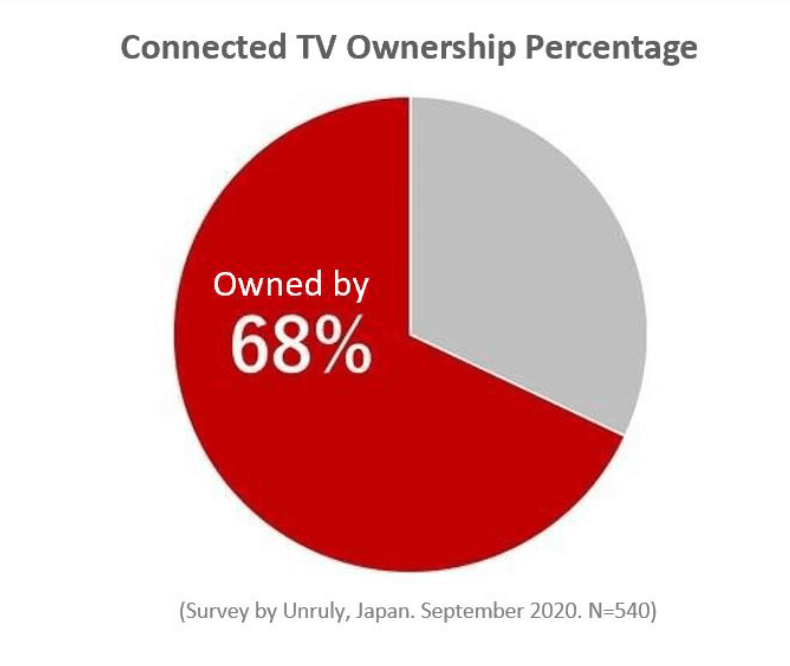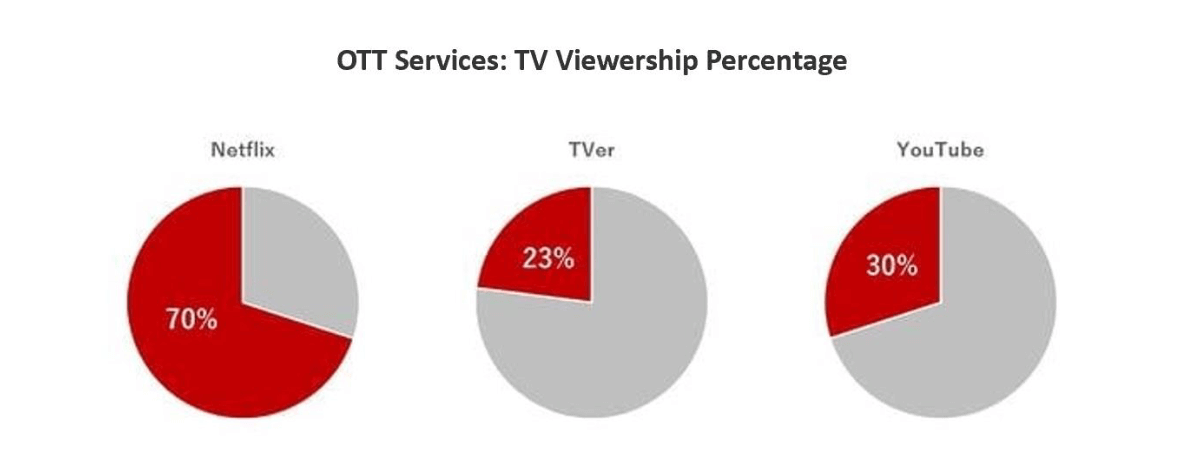We hear the term “connected TV” a lot these days, but how widespread is it? What do consumers watch on their connected TV? This article examines the reality of connected TVs, which have somehow made their way into our lives.
1. What is Connected TVs?
— Overview
A connected TV is a TV device that can be connected to the Internet.
There is more than one way to connect a TV to the Internet: the simplest is to purchase a smart TVs with an operating system, but there are other ways, including through an Internet-capable Blu-ray player or game console, Google’s Chromecast, or Amazon’s Fire TV. About half of connected TV owners connect to the Internet via a Blu-ray player.
*1 Source: Unruly. November 11, 2020 “Trends in Consumer Attitude Changes on Watching Connected TV and Ads
—Spread
- Overseas
Connected TV is becoming increasingly popular overseas, especially in the United States. Unlike Japan, where TV programming is basically free of charge, watching TV programs in the U.S. requires a paid cable TV subscription.
The U.S. TV market is said to have changed in 2007 when Netflix launched its video streaming service, which was dubbed “cord-cutters” because many people cancelled their cable TV subscriptions in exchange for Netflix subscriptions. The growth of video streaming services, including connected TV, also helped to fuel the rapid adoption of connected TV in the United States. - Japan
In Japan, unlike in the U.S., people can mostly watch TV programs for free, and many people hesitate to pay for video streaming services. However, video streaming services and connected TVs are spreading steadily Japan, although the situation is a few years behind that of the U.S.
Netflix and Amazon Prime Video launched their video streaming services in Japan in 2015, and the number of connected TV owners has increased dramatically over the past few years, helped by the increase in time spent at home since 2020. Today, about 70% of Japanese TV viewers own a connected TV, making it a very familiar piece of equipment.

Source: Unruly. November 11, 2020. Created by the author using “Trends in Consumer Attitude Changes on Watching Connected TV and Ads”
2. What are consumers watching on Connected TV?
—The growth of video streaming services and conventional TV
Connected TV is nothing more than the device, terminal, or the means of watching videos. Now that connected TV is widely used, what kind of video content are consumers watching on them?
According to an April 2021 survey conducted by Impress Corporation, live TV programs were the most frequently viewed content on a daily basis at 69.9%, followed by pre-recorded TV programs at 54.9%. Linear broadcast programs from TV stations remain popular, followed by video sharing services such as YouTube at 45.9% and free video streaming services such as TVer at 30.7%.
Compared to two years ago, live TV viewing remained almost unchanged at 68.3% to 69.9%. On the other hand, video sharing services grew by 22% (from 37.6% to 45.9%), free video distribution services by 18% (from 25.8% to 30.7%), and paid video distribution services by 60% (from 16.0% to 25.6%), indicating that use of video sharing and streaming services has grown rapidly over the past few years. It also shows that TV is catching up. Traditionally, the only option for enjoying video content was to watch the current program or a pre-recorded program, but the rise of YouTube, Netflix, Amazon Prime Video, and other streaming services has diversified the options.
These video distribution services are gaining momentum and are often referred to as OTT (Over the Top) in the advertising world.

2021)
Source: Impress Corporation. May 20, 2021. Created by the author based on “Video Streaming Business Research Report 2021.”
—OTT video streaming services
OTT refers to content provided through an Internet connection. In a broad sense, it includes social media and platforms like Spotify, but in the advertising industry, OTT is often used to refer exclusively to video content. OTT specifically includes video sharing and streaming services such as YouTube, Netflix, Amazon Prime Video, TVer, Abema, GYAO!, a characteristic shared with a group of services referred to as VOD.
—OTT viewed on connected TV
OTT can be viewed on devices other than connected TV, smartphones and PCs. To what extent is connected TV being used to watch OTT?
About 70% of Netflix users use TV to watch content, indicating that many people prefer to watch movies, dramas and other content on larger screens.*2 According to TVer, Inc., users of its service on connected TV was 22.7% as of February 2021, a rapid increase from 7.5% to 22.7% in just one year! *3 YouTube, which has a strong image of being viewed on smartphones and PCs, also announced that as of March 2021, more than 20 million people per month in Japan were viewing YouTube on their TV screens.*4 Considering that YouTube has around 65 million monthly users, it can be said that approximately one in three people are watching YouTube on their connected TV.
*2 Source: Vox. March 7, 2018. “Netflix data: 70 percent of viewing happens on TVs”
*3 Source: TVer. April 13, 2021 “TVer ads on connected TV is launching. INTAGE and Aoyama Gakuin Univesity joint research on CTV advertising effects. Joint release of CTV research scheme with INTAGE is coming for the first phase of the collaboration.”
*4 Source: Think with Google. July 9, 2021. Monthly YouTube users watching on TV surpasses 20 million

3. Ads on connected TV
—OTT is recommended for running ads on connected TV
In the old days, if you wanted to advertise on a TV screen, you had only one choice: TV commercials. However, with the proliferation of connected TV and OTT, new options have emerged for ad delivery to TV screens, such as OTT and YouTube ads. Therefore, OTT advertising mainly refers to advertising on TVer, Abema, and GYAO!
Compared to TV commercials, OTT advertising has the great advantage of flexible targeting and operation. OTT ads are basically ads that cannot be skipped, and are aired during professionally produced programs, making it possible for viewers to watch ads in a viewing environment as good as that of TV commercials. OTT ads are basically ads in exchange for OTT providing content to viewers free of charge, and viewers understand this, so there is little aversion or discomfort with ads.
—The growth of OTT ads
The OTT advertising market is growing rapidly with the spread of connected TV and OTT. In the U.S., where the wave is coming several years earlier than in Japan, the OTT ad market is expected to reach 1.47 trillion yen by 2023. Japan’s OTT advertising market is also expected to reach 55.8 billion yen by 2024.*5
*5 Source: SMN. October 22, 2020 “SMN Conducts Domestic Connected TV Advertising Market Research – Market size is expected to be 10.2 billion yen in 2020, and is forecast to be 55.8 billion yen by 2024”
OTT advertising, like YouTube advertising, is an in-stream type of video ad in which ads are aired during video content. The in-stream video advertising market is expected to reach 318 billion yen by 2024. If the market grows as projected, OTT advertising will account for approximately 6% of the in-stream video advertising market in 2020 but will account for approximately 18% in 2024. In other words, the OTT advertising market is expected to develop faster than the growth rate of the overall video advertising market.*6
*6 Source:
Screens. January 13, 2021 “The Future of Connected TVs, Digital Video and Television as Seen from the OTT Usage Survey – “CCI BROADCASTING FORUM” Report”
dentsu. March 10, 2021”A Detailed Analysis of 2020 Advertising Expenditures in Japan Internet Advertising Media Expenditures”
ExchangeWire. December 18, 2020. “CyberAgent discusses the video ad market under Covid-19 and its efforts looking forward to 2021 [interview].”
4. Summary
Connected TV users are growing rapidly both internationally and domestically, due in part to the increase in time spent at home. Connected TV is one of the most promising options as a delivery medium for ads. Consumers are enjoying YouTube and OTT on their connected TV, and advertising on OTT has been favorably accepted in exchange for free content, and the OTT advertising market is expected to continue growing.
Want to know more about Connected TV?
Contact us to discuss how we can work together.

Irep Inc. is an award-winning global digital marketing agency based in the San Francisco Bay Area. Our headquarters are in Tokyo and our network spans more than 20 countries. In Japan, we are ranked No. 1 for performance-based marketing. We also offer highly specialized market entry, as well as integrated marketing and localization services. Since 1997, our data-driven solutions have effectively led our diverse international clientele to continuous success in Japan, Asia, and beyond.
Irep Inc.
LinkedIn: https://www.linkedin.com/company/irepinc
Email: info@irep.inc
Address: 900 Concar Dr. Suite 400, San Mateo, California 9440


